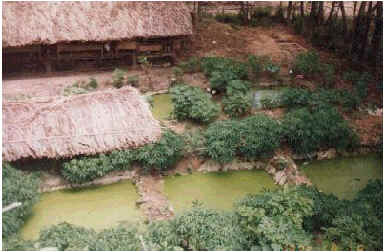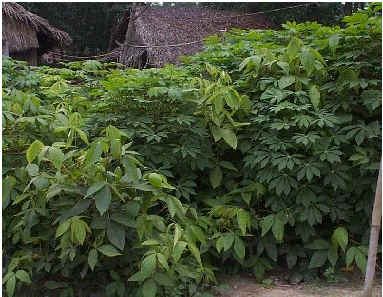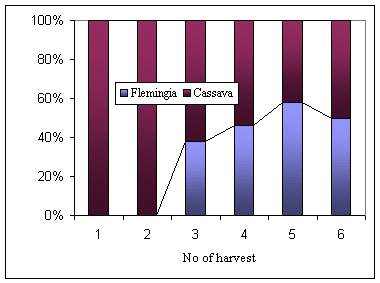|
Figure 1: Fattening Zebu cattle with molasses-urea and foliage from cassava or sweet potato, with or without 400 g/day of soyabean meal (Source: Ffoulkes and Preston 1978) |
| Back to contents |
|
Workshop-seminar "Making better use of local feed resources" January, 2000. SAREC-UAF |
The growing of cassava as a perennial forage plant requires heavy application of fertilizer, preferably of organic origin (eg: 100 tonnes/ha/year). However, by associating the cassava with a perennial legume shrub such as Flemingia macrophylla it appears that the fertilizer application can be reduced to 20 tonnes/ha applied at time of planting. The foliage of cassava can be fed fresh or as "hay" after sun-drying. During the rainy season (and in the dry season with irrigation) the cassava can be harvested at intervals of 50 to 70 days with protein yields in the range of 3 to 4 tonnes/ha/year.
The crude protein in the foliage is in the range of 23 to 28% in dry
matter. There are indications that at levels of 30% of the diet dry matter
the foliage produces sufficient ammonia for rumen fermentation and that part of
the protein "escapes" from the rumen thus providing "bypass"
nutrients to the animal.
Research at CIAT in Colombia (Moore 1976) demonstrated high potential yields of
foliage when cassava was managed as a semi-perennial crop with repeated harvesting at 2-3 month intervals.
In the Dominican Republic, Ffoulkes and Preston (1978) evaluated the fresh foliage as
a source of protein and fibre for supplementing a liquid diet of molasses-urea for fattening cattle.
Growth rates were over 800 g/day and were not improved when 400 g/day of
additional soya bean meal was given (Figure 1). The cassava foliage appeared to
be a better source of "bypass" protein than sweet potato foliage.
|
Figure 1: Fattening Zebu cattle with molasses-urea and foliage from cassava or sweet potato, with or without 400 g/day of soyabean meal (Source: Ffoulkes and Preston 1978) |
The impact of the technology was positive at the level of the animal but was not sustained agronomically. Yields of foliage fell rapidly with successive harvests and were negligible by the fourth harvest, due to a lack of appreciation of the need to return to the soil the considerable amounts of nitrogen and other nutrients removed by repeated harvesting (T R Preston, unpublished observations).
Two approaches are being followed. The first is to recycle manure from goats fed with the cassava foliage, at an application rate of 2 kg/m² after each harvest, or with equivalent amounts of effluent from a biodigester (Figures 2 and 3). This is equivalent to about 100 tonnes fresh manure/ha/year. The second approach is to associate the cassava with a shrub legume that has similar growth characteristics. Flemingia macrophylla has so far proved to be the most suitable companion crop (Figures 4 and 5).

Figure 2: Cassava as a "live"fence around |

Figure 3: Cassava integrated with the biodigester and duckweed ponds |

Figure 4: Cassava in association with Flemingia macrophylla |

Figure 5: Flemingia macrophylla after harvesting the cassava |
Total
forage yields over a 12 month growing cycle were slightly lower when cassava was grown
in association with the Flemingia (46 tonnes/ha of forage with only one 20 tonne/ha application of
manure at time of planting) or in monoculture (55 tonnes/ha forage but with 100 tonnes/ha of manure
spread over the year growth cycle) (Figure 6).
|
Figure 6: Fresh foliage yield from cassava in
monoculture or associated |
The Flemingia macrophylla grew more slowly than the cassava in the first two months (Figure 7) such that the first harvest was taken at the same time as the third harvest of the cassava. In the 4th, 5th and 6th harvest the growth rates and the biomass production were similar for both forages. Over the full cycle of 6 harvests the Flemingia contributed 37% of the total fresh biomass of the association.

Figure 7: Proportions of cassava and Flemingia in successive harvests (% fresh biomass) |
Three cassava / legume associations were compared in Cambodia (Figure 8): Cassava alone or with Flemingia macrophylla, Desmanthus virgatumi or Stylosanthes. Both Flemingia macrophylla and Desmanthus virgatumi were able to compete with the cassava but not the Stylosanthes. The proportion of legume in the harvested biomass was higher for the association with Desmanthus virgatum than with Flemingia macrophylla. Total biomass yield was also highest for the association of Cassava and Desmanthus. The latter association is interesting since it has been observed that Desmanthus virgatum is much more palatable to goats than Flemingia macrophylla.

Figure 8: Yield of foliage in four cassava / legume associations (cassava alone, with F. macrophylla, with Desmanthus virgatum, or with Stylosantheses) (mean of 3 harvests at mean 92 day interval from planting) in Cambodia |
Cassava can be managed as a perennial forage shrub with high yields of protein provided:
It is fertilised heavily (100 tonnes/ha/yr) with livestock manure, or
It is grown in association with a vigorous legume such as Flemingia macrophylla
On the basis of preliminary observations in Cambodia, it appears that Desmanthus virgatum also may be an appropriate shrub legume to associate with cassava
Ffoulkes D and Preston T R 1978 Cassava or sweet potato forage as combined sources of protein and roughage in molasses based diets: effect of supplementation with soybean meal. Tropical Animal Production (3) :186-192
Moore C P 1976 El uso de forraje de yuca en la alimentacion de rumiantes. Seminario Internacional de Ganaderia Tropical, Acapulco, Mexico